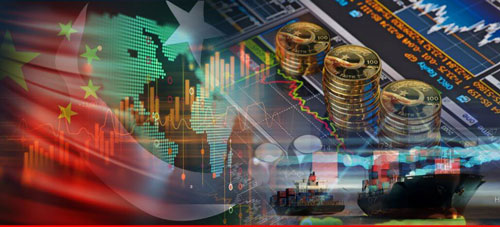THE broader dimension of China-Pakistan Economic Corridor (CPEC) is that it is a project of larger regional and political integration. Besides, CPEC provides economic prosperity for various regions of Asia, especially the economically deprived regions. Pakistan is a key state for the success of this project since it (CPEC) covers over 3000 kilometre area of Pakistani geopolocialitics. According to a recently published book, “The China-Pakistan Economic Corridor of the Belt and Road Initiative: Concept, Context and Assessment” CPEC is a project of immense significance for Pakistan and China. The book provides an in-depth analysis of Belt and Road Initiative (BRI); the gigantic Chinese project, which encompasses a set of corridors and maritime silk route spreading over three continents: Asia, Africa and Europe. Siegfried O. Wolf, the author of the book, had researched and highlighted the philosophy behind Belt and Road Initiative (BRI) and more about the strategy of Economic Corridors.The primary objectives of having these economic corridors are to connect China with its neighbours and then other regions and countries beyond Asia. It is pertinent to mention that the ancient Silk Road started during the westward expansion of Chinese Han Dynasty from 206 BCE to 220 CE.
Besides, China needs energy resources and raw material in order to maintain its sustained growth and economic development. The huge industrial base of China lacked the needed energy resources on a long-term basis. China is currently importing over 50% of its energy resources from the Middle East region and African countries. Besides, it imports over 30% oil and gas from the Central Asian region and Russia. Chinese imports and energy resources from the Middle East and Africa have to pass through the Indian Ocean region, before entering into the South China Sea. Since Indian Navy is dominating the Indian Ocean Region (IOR), therefore in a future scenario there may be constraints for Chinese trade at the Strait of Malacca; a key point in the Indian Ocean. The Strait of Malacca is a narrow passage of water between the Indonesian island of Sumatra and the Malay Peninsula. Findings of all such studies concluded that in case there is a blockage of Malacca Strait, there are less alternative routes available to China for its trade and oil imports. Other available alternatives are either incompatible to take on the weight of modern ships and heavy traffic or else causing heavy expenditure owing to longer routes.
The CPEC is the only alternative and a secure route, which can guarantee an uninterrupted flow of Chinese trade and energy resources. It is the shortest route, less expensive and more secure for the sustenance of Chinese energy and trade needs. Chinese leadership had selected CPEC after years of deliberations while weighing its pros and cons. President Xi Jinping is the architect of this project, who has been embarked upon the position of life-time President and Secretary General of Communist Party of China (CPC). From the Chinese perspective CPEC is the most significant part of BRI. In a rapidly evolving regional and global security situation, Pakistan holds the key for the continuance of Chinese economic development by providing a secure energy corridor.
Sequel to the development and operationalization of Gwadar Port, completion of CPEC as per schedule is the real challenge, facing China and Pakistan. Two security divisions under Pakistan Army have been established to ensure physical security of the CPEC route. Halford John Mackinder declared Pakistani geopolitics as the ‘Geographical Pivot of History’; connecting various regions of Asia, politically as well as economically. Upon its completion, CPEC will integrate entire regions of Asia including India. On its part, India has been opposing both BRI and CPEC without a prudent clarification.
Apart from New Delhi, there is a discomfort at Washington over the developments on CPEC. On more than one occasion, former US Deputy Assistant Secretary Bureau of South and Central Asian Affairs warned Pakistan that, “CPEC is not about aid.” Washington also warned Islamabad that Pakistan may face a long-term economic crisis if it continues allowing ‘China keeps pursuing its giant infrastructure push’ over and across its geopolitics. Alice Wells further said, “CPEC relies primarily on Chinese workers and supplies, even amid rising unemployment in Pakistan”. Pakistan is certainly aware of its economic crisis and rising unemployment in the country. It needs to get the maximum benefit from the CPEC and its associated projects since it covers the maximum geopolitics of Pakistan. Moreover, it must secure the jobs related to CPEC for reducing the unemployment in the country. Nevertheless, Islamabad fully understands the real motives behind US concerns over CPEC.
Indeed, Washington’s anxiety over the CPEC is part of global power politics where the US views China as its peer competitor. In the wordings of Ashley J. Tellis, Alison Szalwinski, and Michael Wills, the United States “has shifted from viewing China as a strategic partner to a strategic competitor”. Upon completion of the first two decades of the 21st century, Washington contends Beijing in a number of areas like domination of Asia-Pacific, control of Indian Ocean, China’s technical and technological advancements, Chinese military modernization and domination over global trade and commerce. BRI and CPEC are the projects for advancing and stimulating the regional and global trade and commerce. In the 21st century, economy (trade and commerce) drives world politics, unlike military domination of the 20th century. It is the trade war between Washington and Beijing which executes both BRI and CPEC.
The broader dimension of CPEC is that; it is a project of larger regional and political integration with wider economic dividends for the founding states as well as the connecting regions and states. While the project has entered into its second and decisive phase, Beijing must continue un-interrupted funding in the light of agreed terms and conditions.
Moreover, with the change of guards at the White House (Biden Administration) there should be new engagements promoting cooperation rather than conflicts between Beijing and Washington. Nevertheless, despite opposition to the project from rival forces, Pakistan and China must double their efforts for the timely completion of this giant project. In order to fully benefit from CPEC there is a dire need that regional Asian states (energy deficient and energy efficient states) correctly re-asses their future priorities and extend cooperation towards its timely completion with a wider participation. Indeed, a regional political and economic integration would pave the way for a wider regional peace and economic prosperity of all states of Asian Continent.







